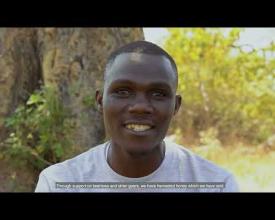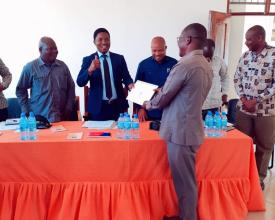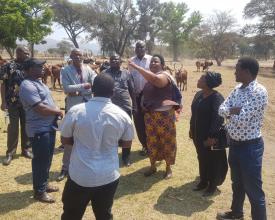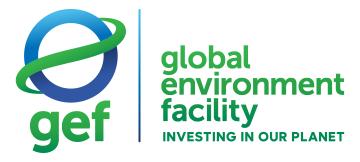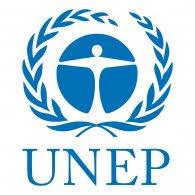
Enhancing Tanzania's Enabling Environment for Sustainable Landscape Restoration
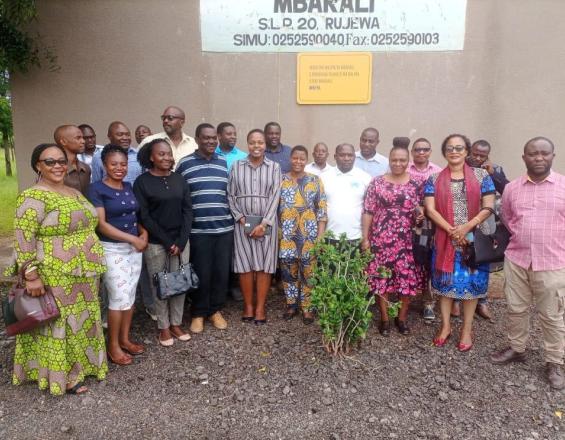
The Restoration Initiative (TRI) in Tanzania, in collaboration with key partners, has contributed to enhancing in-country enabling environment for sustainable landscape restoration (SLR) by strengthening relevant national policies, legislations and strategies, improving institutional capacity and incorporating cross-sectoral planning mechanisms supporting SLR. With these actions, TRI has directly contributed to the formulation of the National Forest and Landscape Restoration Strategy. This strategy is aligned to the newly launched policy milestones - the National Environmental Master Plan for Strategic Intervention, the National Forest Policy Implementation Strategy, and the National Environmental Policy. Together, the policies and strategies outline strategic objectives for landscape restoration, define priority measures and actions to be taken for FLR, set critical restoration targets, establish stakeholder roles on restoration, and establish financing and monitoring arrangements for restoration.
TRI is a GEF-funded project
Context
Challenges addressed
The greatest challenges TRI Tanzania as well as other restoration projects are facing is competing and conflicting conservation and socio-economic priorities. Policy revision and reformulation has been slow, with existing frameworks about a decade older with limited potential to address emerging challenges and opportunities. Similarly, politicians’ priorities can shift during election cycles at the expense of conservation objectives. Producing policies that withstand transitions in regimes and priorities is essential in promoting FLR. The highest policy priority is often given to socio-economic development, which, without the sustainability lens, translates into incompatible land uses and degradation of forests and landscapes. Restoration policies aim to balance restoration goals with economic development and demonstrate how conservation can ultimately benefit and sustain socio-economic development.
Location
Process
Summary of the process
By reviewing relevant national policies, identifying their gaps and providing recommendations, incorporating cross sectoral mechanisms, and building institutional capacity for mainstreaming SLR in sectoral and local action plans, TRI Tanzania successfully contributed to enhancing the enabling environment for SLR. The policy review resulted in the National Forest Implementation Strategy, which consists of reviewing an existing forest policy with a situational analysis and establishing restoration targets. Through the review and generation of concrete policy recommendations, TRI helped define priorities on policy making. TRI and its Government and CSO partners contributed to the preparation of the National Forest and Landscape Restoration Strategy, revision of the National Environmental Policy and formulation of the National Environmental Master Plan for Strategic Intervention and the National Forest Policy Implementation Strategy. Similarly, the greater consideration of cross-sectoral mechanisms in the review and extension of new policy elaboration to more stakeholders, ensured the policies considered cross-cutting issues. Ultimately, the provision of tailored training helped build institutional capacity for mainstreaming SLR.
Building Blocks
Reviewing Relevant National Policies: Identifying Gaps and Generating Recommendations
TRI Tanzania collected baseline data in the areas of policy, development plans, and legal frameworks that impact SLR initiatives and evaluated the extent to which they supported SLR, including community and private sector participation in restoration. This process resulted in the identification of policy gaps and in generating key recommendations for enhancing regulatory enabling environment for SLR. The proposed high-level and intervention level policy recommendations is expected to result into the reformulation of regulatory frameworks at national and local level. In addition, the Project conducted a environmental and social safeguards study in the seven districts implementing the project to map potential environmental and social risks. The safeguards report informed the design of the Environmental and Social Management Plan detailing key measures and strategies for minimizing key risks and negative impacts that may arise during the project’s implementation.. This robust review allowed TRI to push priority interventions in its policy development work and ensure any negative impacts are mitigated.
Enabling factors
The review of national policies and the identification of existing gaps in restoration and generation of concrete recommendations was made possible through the technical input through TRI Tanzania experts and partners. Further, this was enabled by stakeholder interest and willingness underpinned by shared vision and strategic priorities. In addition, effective stakeholder engagement and coordination further ensured successful policy review.
Lesson learned
By reviewing existing restoration related policies, legislations and plans, TRI Tanzania has learned lessons around where restoration policy and legal frameworks need to be strengthened and which existing actions have been successful in facilitating restoration. Reviewing the existing frameworks also provides information on where the expertise from the different agencies and stakeholders can be used to better improve restoration policies and more efficiently implement them. Additionally, TRI Tanzania initiated to identify the environmental and social safeguards, the project learned what strategies and measures needed to be established to minimize the negative impacts that might happen due to the activities undertaken by the project on the ground. Through its thorough policy review and identification of safeguards, TRI Tanzania learned what policy gaps needed to be addressed to enhance regulatory frameworks that are supportive of SLR as well as suite of strategies for safeguarding the environment and local communities.
Establishing Cross Sectoral Planning Mechanisms for Sustainable Land Restoration
To help incorporate cross sectoral planning mechanisms and frameworks, TRI Tanzania has worked to establish and support a cross-sectoral national working groups (a national SLR committee) with a core mandate to promote sector integration as well as guide and coordinate the implementation of SLR programs. This aims to ensure Tanzania achieves its AFR100 / Bonn Challenge Restoration target. Further, TRI has initiated the establishment of landscape level multi-stakeholder platforms to address competing and conflicting land use interests towards a shared vision. Cross-sectoral planning mechanisms are expected to address silos in planning, decision making and implementation of SLR initiatives to enhance biodiversity conservation, climate resilience and local livelihoods. Stakeholder engagement and participation is provided for in different policy frameworks defining the position as well as the specific roles and responsibilities of the various stakeholders and sectors. By addressing multi-sector issues and including diverse stakeholders, TRI was able to incorporate cross sectoral planning mechanisms in SLR policies that also address cross-cutting issues such as good governance, resource mobilization, and gender.
Enabling factors
The cross-sectoral mechanisms would not have been successfully established and functional without interest and willingness amongst stakeholders. Shared challenges, desire for a common vision and clearly defined priorities catalyzed the need for concerted efforts and effective communication, engagement and coordination ensured effective stakeholder participation in SLR working groups. The mechanisms provide opportunities for addressing and capitalizing on conflicting priorities and synergies, leading to win-win conservation and socio-economic outcomes.
Lesson learned
By working to incorporate cross sectoral planning mechanisms and contribute to policy processes that use multi-sector and multi-stakeholder participation to address cross-cutting environmental issues, TRI Tanzania learned what interests and priorities each of the different sectors have and how restoration can be influenced and implemented by these sectors. Additionally, with the use of the cross-sectoral working group to guide and coordinate SLR work, TRI learned how the various agencies and stakeholders work together to negotiate, formulate policy and mainstream restoration work. The process allows TRI to identify where relationships, alliances and partnerships can be established and strengthened, which synergies can be leveraged, and how the different stakeholders approach restoration policy process and implementation. All these lessons taught TRI how to best to design and operationalize cross-sectoral mechanisms that integrate sectoral interests and priorities and a range of cross-cutting issues.
Assessing and strengthening institutional capacity for mainstreaming landscape restoration in sectoral plans
To ensure landscape restoration is adequately mainstreamed in sectoral and local action plans, TRI Tanzania undertook an assessment on institutional capacity for mainstreaming restoration in institutions with mandates related to SLR. The undertaking aims at identifying key capacity gaps and generating recommendations for enhancing institutional capacity for mainstreaming landscape restoration in the target plans. Target sectors are those with mandates relevant to SLR such as agriculture, livestock, land, water and mining. On enabling Ministerial mandates and operational arrangements, the assessment revealed low levels of staffing and competence on SLR. In terms of supportive policy and legal instruments, existing sectoral policies and strategies need to be reviewed and updated to accommodate emerging environmental global issues and ambitions. Cross-sectoral coordination structures exist, most of which are passive with limited capacities to coordinate SLR. Identified gaps and recommendations will inform the design and implementation of capacity building modules and programmes to enhance restoration integration in cross sectoral plans. Continuous strengthening of institutional capacity is a critical step towards supporting environmental restoration and biodiversity conservation in Tanzania.
Enabling factors
TRI was able to build institutional capacity for mainstreaming SLR because of the expertise the project gathered. Other major factors are interest and willingness of target Ministries and Local Government authorities in participating in the assessment. The effectiveness of the capacity building programme depends on the extent that it reflects and addresses stakeholder issues. Critically, the participatory ROAM assessment informed the National Environmental Masterplan formulation process and ensured the right areas were prioritized in recommendations.
Lesson learned
The existence of conservation regulatory frameworks alone is insufficient to advance and sustain restoration objectives in the face of competing sectoral priorities and land uses. A critical process is integration of restoration in sectoral and local action plans. Mainstreaming is critical for minimizing negative impacts of regulatory frameworks on SLR and maximizing synergies between restoration and development objectives. By undertaking assessment and delivering tailored trainings, TRI Tanzania has learned how to strengthen institutional capacity for mainstreaming SLR in sectoral and local plans. Institutional capacity for mainstreaming SLR comprises of both in-house technical capacity and adequacy of regulatory frameworks. Identification and assessment of the relevancy and strength of existing frameworks defines the nature of impact of such frameworks on SLR.
Impacts
The policy milestones facilitated by TRI and its partners in Tanzania are contributing to major differences with previous practice related to restoration, catalyzing a broader uptake of restoration goals and actions, and marking major steps towards the country and project’s ultimate restoration goals. While in previous frameworks issues of landscape degradation and restoration were addressed in silos, the newly established frameworks have promoted a more integrated approach that brings together stakeholders as well as different sectoral ministries, CSOs and the private sector. The current frameworks are transformative in that restoration is more prominent with clear targets and mechanisms on how to deliver on Tanzania’s restoration agenda. They outline the key drivers of degradation, degradation hotspots and priority restoration interventions, which will inform programming within and outside the government and facilitate the development of measures addressing the key drivers of degradation in the country. With enhanced policy and regulatory framework that promotes restoration and sustainable land use, local actors will be better able to pursue restoration activities while securing their livelihoods. Additionally, the four frameworks policies will ultimately contribute to the realization of Tanzania’s restoration, biodiversity and climate resilience commitments and targets.
Beneficiaries
The beneficiaries are ministries and agencies, which gain guidance on mainstreaming and mobilizing SLR implementation. Local authorities benefit as local plans integrate SLR aspects which will improve conservation and protection of the environment.
Sustainable Development Goals
Story
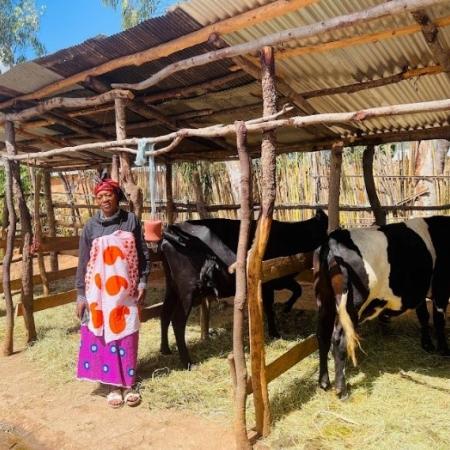
“For many years, I have been living on subsistence farming. Due to low yields, I highly depended on forest resources for collecting firewood for household use and income. We have used a small number of cattle to graze freely in the forest reserve. We noticed the trend of a declining landscape but cared more about our well-being and our livestock.
As farmers, we had challenges – inadequate rains, poor farming practices, deteriorating soils and pests and diseases. All these resulted in very low yields. Our cattle did not increase in numbers as anticipated due to limited access to nutritious fodder and inadequate extension services. The combined income from crop and milk sales couldn’t help meet family needs. I heard about The Restoration Initiative at a community meeting organised to sensitise villagers on environmental protection and sustainable livelihood practices. TRI’s community development officer called for community participation in this project to help address land degradation and improve our livelihood. Through TRI, fellow members of our women's group and I were supported with three improved local cattle breeds and received training on raising them. We were trained to grow fodder for livestock and apply climate-smart agriculture (CSA) practices and technologies. We were further supported in post-harvest management and marketing of milk. With TRI support, milk yield has increased more than five-fold from 1-2 litres to 10 litres per cow daily. In terms of revenues, based on an average price of TZS 950 (USD 0.41) per litre, this represents an increment in revenues from TZS 1,900 (USD 0.8) to TZS 9,500 (USD 4.1) per cow per day.
We are just at the beginning. Rearing improved local cattle is a new thing to us in this community. We are seeing the value of this project, and so are many community members, particularly women and youth. Other villagers are contacting us and the district officials to connect in this initiative. More agro-pastoralists are eager to convert to sustainable livestock management practices to reduce encroachment and degradation of the forest reserves and water sources. We are now operating as a group, which is a farmer field school in our community. Our plan, however, is for each group member to have their own cattle. We are keen to intervene along the milk value chain and explore a bigger market for our products."

